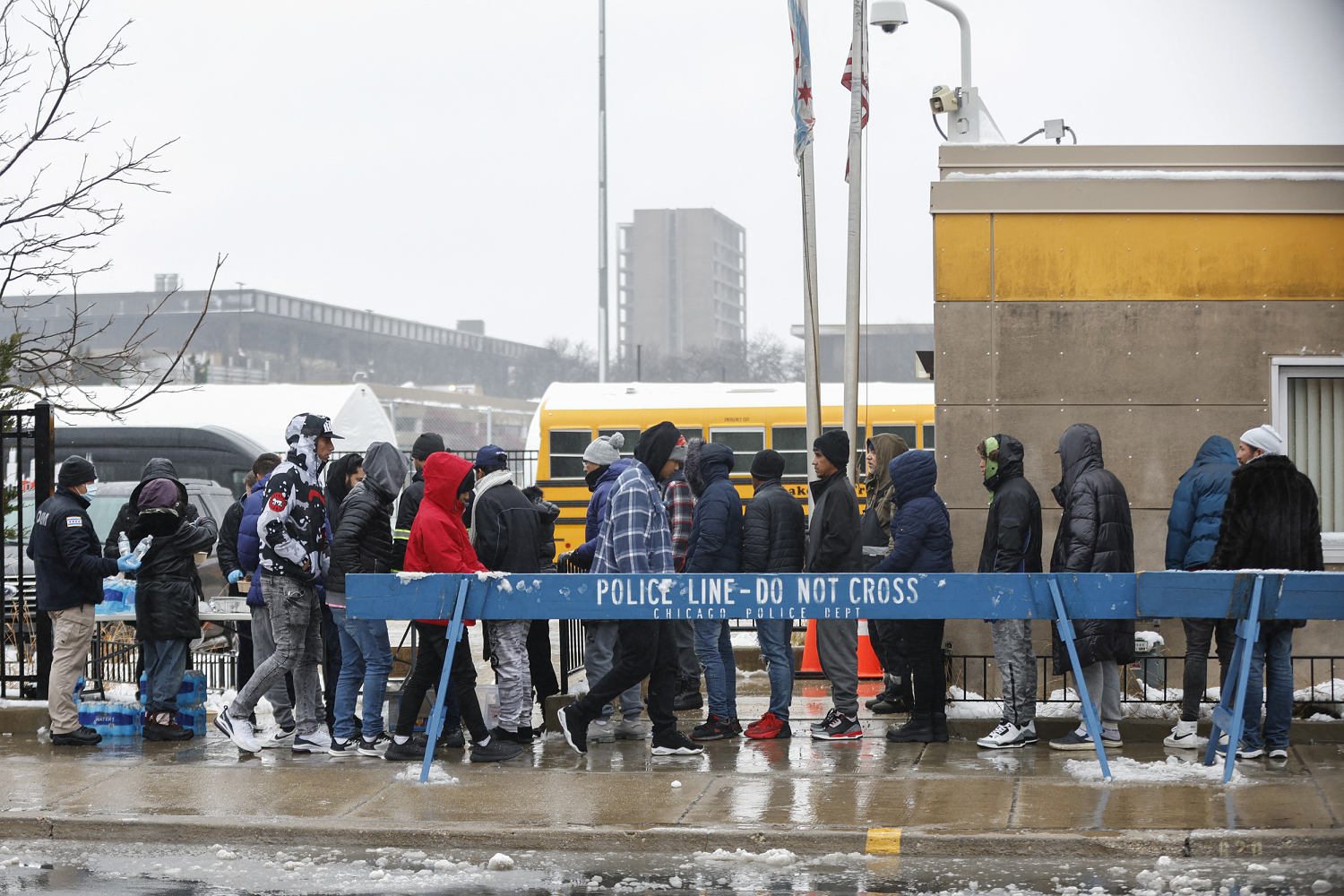
The city of Chicago will overhaul its migrant response strategy, including by closing its “landing zone” and migrant-only shelters, as it responds to a decline in the number of people arriving to the city in recent months.
Chicago, along with New York and Denver, have had to adapt over the past two years as their migrant populations sizably grew after Texas Gov. Greg Abbott started busing thousands of people to Democratic cities in 2022. The cities have opened shelters, created offices and allocated millions of dollars to address the rise in new residents. Chicago has received more than 50,000 migrants, many of them families.
But the number of migrants arriving in the city has dropped dramatically in recent months as a result of Biden administration asylum restrictions.
“This transition is in line with the sharp decline in migration to Chicago and our current budget realities,” Mayor Brandon Johnson said in a statement Monday. “We continue the dedicated work with our agencies and community partners as we have from the beginning to usher in the next phase.”
The city is still housing nearly 5,000 people in its migrant shelters.
That’s a sharp decline from the peak of about 15,000 migrants that had squeezed the city’s budget and resulted in the evictions of more than 2,700 people from city-operated shelters in the spring to conserve resources and make room for newcomers. A majority of those migrants ended up re-entering the migrant shelter system.
Chicago will begin to transition out of operating a separate migrant shelter system this week and will move toward “a unified sheltering system to serve all Chicagoans” by the new year, Johnson said.
The mayor said the city is “shifting to a more cost-effective, equitable, and strategic approach that addresses homelessness for all who need support in the City of Chicago.”
The mayor said a city and state partnership will add 3,800 beds to its legacy homelessness services system, “more than doubling our 3,000 shelter bed capacity,” which is nearly full. Officials said that includes 2,100 city-funded shelter beds and 1,700 state-funded beds.
Once the two systems merge, the rules of the legacy homelessness system will apply, meaning there will no longer be exit days or extension policies, officials said.
“In the legacy system, there is not an exit date, so people will be allowed to stay in the system,” Brandie Knazze, the commissioner of the Department of Family and Support Services, said Monday at a news conference.
The city will also close its “landing zone,” where newly arrived migrants could get shelter placements and other resources, by Dec. 31.
In the meantime, the city said it was also limiting first-time shelter placement at the migrant landing zone to families and individuals who have been in the country for 30 days or less. Placements will continue to be for 60 days, and 30-day extensions will be eliminated for anyone in the shelter system or newly entering it, with limited exceptions.
Chicago is not alone in changing in its migrant response strategy. Last month Denver officials announced that that city would not renew an ambitious plan designed to help newly arrived migrants transition into more stable lives through temporary housing, job training and other supports. Denver also cited a decline in arrivals because of the Biden administration’s border policies.
At the news conference Monday, Johnson said that when he came into office last year, “we inherited a humanitarian crisis with scores of buses with new arrivals sent from the southern border without notice, care or any coordination. This act was meant to destabilize Chicago as a welcoming sanctuary city.”
“We fought back and showed the world just how welcoming we can be,” he said.
Johnson called for additional federal help to assist the city and state ensure that people do not end up without shelter.
Chicago to begin closing separate migrant shelter system
The Rev. Kenneth Phelps, who has assisted migrants in Chicago with housing and resources over the last two years, said he believes the new system “not only makes the shelter economy more affordable, but it also addresses the equality concern.”
“I think to some degree it just makes it a fair system, for not only new arrivals, but for those who had extenuating circumstances as any resident of Chicago,” Phelps said.
“The bottom line is, from an economic standpoint, there was no way that the city could sustain the migrant shelters,” Phelps said, adding that the major decrease in new arrivals has allowed the city to take necessary steps to create an economy it can sustain while still providing shelter for migrants.
Alisa Bhachu, the executive director of the Chicago Refugee Coalition, said there were many things the mayor’s office has done right in terms of setting up the “impressive” migrant shelter system. The coalition has been in partnership with the city to provide direct services, aid and volunteer training in response to the new arrivals mission since April 2022.
She said while she understood the budgetary restraints and the decrease in new arrivals, “the unification into a one shelter system could present some concerns in terms of the distinct differences” between the two populations and their needs.
“New arrivals come with concerns of legal issues and needing support in terms of advocacy,” adding that the “large majority of individuals who’ve been bused up from the southern border are young families,” Bhachu said.
She also said that just because the migrant shelter system is winding down, “it doesn’t mean that new arrivals are going to stop coming to Chicago, or that the need for Chicagoans to continue to prioritize a response is necessarily changing.”
“I would just encourage Chicagoans to understand that this is an opportunity for them to continue to serve a population that really has had extraordinarily difficult circumstances, and that just because the shelter system is changing doesn’t mean that our response to care for new arrivals should become less of a priority,” she said.



